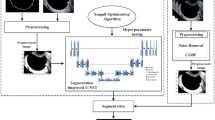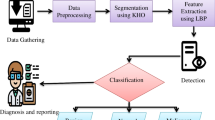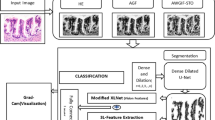Abstract
Ovarian Tumour is one of the common generally occurring tumours in females. Transvaginal (US) ultrasonography is used as a screening examination to identify the appearance of tumours. But for different types of ovarian tumours, malignancy can only be sustained through medicine. A computerised system to achieve the disclosure and fatality estimate of specific tumours is important to restrict undesirable oophorectomies. This proposed method shows a computerised ovarian tumour segmentation method in the ovarian ultrasound image brought by classification. Because, in this process, an efficient ovarian tumour detection, segmentation and classification system is intended by combining GLCM-contourlet transformation (CT) features and CNN. The proposed system comprises four steps: preprocessing, segmentation, feature extraction, and optimisation and also classification. Primary, speckle noise removal is done by combining boxcar filter and median filter as the pre-processing step at the ovarian ultrasound images. Following the classification system, irregular Ovarian tumour (US) images are presented to the segmentation portion to identify tumours and segments using robust graph-based (RGB) and Fast-Global-Minimisation for Active-Contour (FGMAC) segmentation approach. Following that, GLCM-CT and Ant colony optimisation (ACO) features are obtained from certain noiseless ovarian US images. The enormous amount of features is reduced according to the optimisation of ant colonies (ACO) and the optimisation of the particle swarm (PSO). Eventually, extracted features are given to the Convolutional Neural Network (CNN) classifier to analyse Ovarian tumour US images as abnormal or usual. The proposed system execution is examined in several metrics, and experimental results are compared with existing methods.
Access this chapter
Tax calculation will be finalised at checkout
Purchases are for personal use only
Similar content being viewed by others
References
Luo Y, Liu L, Huang Q, Li X (2017) A novel segmentation approach combining region- and edge-based information for ultrasound images. Biomed Res Int 27:2017
İnik Ö, Ceyhan A, Balcıoğlu E, Ülker E (2019) A new method for automatic counting of ovarian follicles on whole slide histological images based on convolutional neural network. Comput Biol Med 112:103350
Siddique N, Sidike P, Elkin C, Devabhaktuni V (2020) U-Net and its variants for medical image segmentation: theory and applications. ar**v preprint ar**v:2011.01118, 2 November 2020
** J, Zhu H, Zhang J, Ai Y, Zhang J, Teng Y, **e C, ** X (2021) Multiple U-net-based automatic segmentations and radiomics feature stability on ultrasound images for patients with ovarian cancer. Front Oncol 18(10):3428
Gu Z, Cheng J, Fu H, Zhou K, Hao H, Zhao Y, Zhang T, Gao S, Liu J (2019) Ce-net: context encoder network for 2D medical image segmentation. IEEE Trans Med Imaging 38(10):2281–2292
** B, Liu P, Wang P, Shi L, Zhao J (2020) Optic disc segmentation using attention-based U-net and the improved cross-entropy convolutional neural network. Entropy 22(8):844
Srilatha K, Ulagamuthalvi V (2019) A comparative study on tumour classification. Res J Pharm Technol 12(1):407–411
Long J, Shelhamer E, Darrell T (2015) Fully convolutional networks for semantic segmentation. In: Proceedings of the IEEE conference on computer vision and pattern recognition 2015, pp 3431–3440
** S, Su Y, Gao S, Wu F, Hu T, Liu J, Li W, Wang D, Chen S, Jiang Y, Pang S (2018) Deep learning: individual maize segmentation from terrestrial Lidar data using faster R-CNN and regional growth algorithms. Front Plant Sci 22(9):866
Xu Z, Wu Z, Feng J (2018) CFUN: combining faster R-CNN and U-net network for efficient whole heart segmentation. ar**v preprint ar**v:1812.04914, 12 December 2018
Christiansen F, Epstein EL, Smedberg E, Åkerlund M, Smith K, Epstein E (2021) Ultrasound image analysis using deep neural networks for discriminating between benign and malignant ovarian tumors: comparison with expert subjective assessment. Ultrasound Obstet Gynecol 57(1):155–163
Guo P, Xue Z, Long LR, Antani S (2020) Cross-dataset evaluation of deep learning networks for uterine cervix segmentation. Diagnostics 10(1):44
Sergio Rodrigues P, Wachs-Lopes G, Morello Santos R, Coltri E, Antonio GG (2019) A q-extension of sigmoid functions and the application for enhancement of ultrasound images. Entropy 21(4):430
Srilatha K, Ulagamuthalvi V (2021) Performance analysis of ultrasound ovarian tumour segmentation using GrabCut and FL-SNNM. In: 2021 international conference on advances in electrical, computing, communication and sustainable technologies (ICAECT), 19 February 2021. IEEE, pp 1–7
**ng X, Chen Q, Xu Q, Yang S, Liu X (2017) Nonlocal means filtering for polarimetric SAR images based on heterogeneity. J Rem Sens 21(3):434–441
Marques S, Carvalho C, Peixoto C, Pignatelli D, Beires J, Silva J, Campilho A (2019) Segmentation of gynaecological ultrasound images using different U-net based approaches. In: 2019 IEEE international ultrasonics symposium (IUS), 6 October 2019. IEEE, pp 1485–1488
Olofsson K, Carannante V, Takai M, Önfelt B, Wiklund M (2021) Ultrasound-based scaffold-free core-shell multicellular tumor spheroid formation. Micromachines 12(3):329
https://hms.harvard.edu/search-results?as_q=harvard%20ovarian%20cancer
Anoop V, Bipin PR (2019) Medical image enhancement by a bilateral filter using optimization technique. J Med Syst 43(8):1–2
Sahani A, Srilatha K (2014) Image forgery detection using SVM classifier. Int J Adv Res Electr Electron Instrum Eng 3(3)
Srilatha K, Ulagamuthalvi V (2019) Support vector machine and particle swarm optimization based classification of ovarian tumour. Biosci Biotech Res Comm 12(3):714–719
Alsinan AZ, Patel VM, Hacihaliloglu I (2019) Automatic segmentation of bone surfaces from ultrasound using a filter-layer-guided CNN. Int J Comput Assist Radiol Surg 14(5):775–783
Ma J, Wu F, Jiang TA, Zhao Q, Kong D (2017) Ultrasound image-based thyroid nodule automatic segmentation using convolutional neural networks. Int J Comput Assist Radiol Surg 12(11):1895–1910
Reid BM, Permuth JB, Sellers TA (2017) Epidemiology of ovarian cancer: a review. Cancer Biol Med 14(1):9
Author information
Authors and Affiliations
Corresponding author
Editor information
Editors and Affiliations
Rights and permissions
Copyright information
© 2022 The Author(s), under exclusive license to Springer Nature Singapore Pte Ltd.
About this paper
Cite this paper
Srilatha, K., Jayasudha, F.V., Sumathi, M., Chitra, P. (2022). Automated Ultrasound Ovarian Tumour Segmentation and Classification Based on Deep Learning Techniques. In: Sengodan, T., Murugappan, M., Misra, S. (eds) Advances in Electrical and Computer Technologies. ICAECT 2021. Lecture Notes in Electrical Engineering, vol 881. Springer, Singapore. https://doi.org/10.1007/978-981-19-1111-8_6
Download citation
DOI: https://doi.org/10.1007/978-981-19-1111-8_6
Published:
Publisher Name: Springer, Singapore
Print ISBN: 978-981-19-1110-1
Online ISBN: 978-981-19-1111-8
eBook Packages: Computer ScienceComputer Science (R0)




